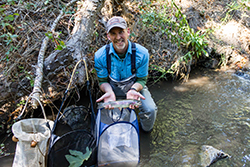
Don Baldwin surveys rainbow trout at the headwaters of a small coastal stream in San Luis Obispo County. These wild trout serve as a seed population for coastal steelhead as some of their progeny may migrate out to the ocean.
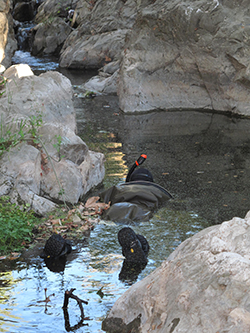
Don conducts a snorkel survey on San Luis Obispo Creek.
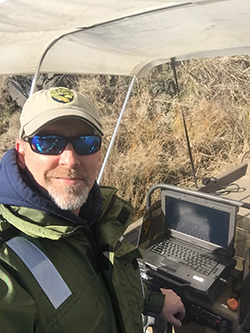
Before he began monitoring steelhead in San Luis Obispo County, Don worked as a steelhead biologist in the Central Valley.
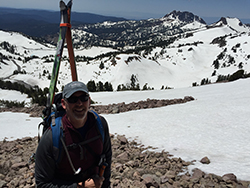
Don takes a summer hike to the summit of Mount Lassen to ski off the top.
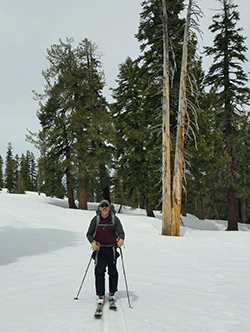
A passionate backcountry skier, Don tours the Sierra through Yosemite National Park.
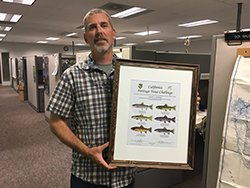 Don successfully completed CDFW’s Heritage Trout Challenge by catching six different native California trout in their historic range.
Don successfully completed CDFW’s Heritage Trout Challenge by catching six different native California trout in their historic range.
Don Baldwin is an environmental scientist with CDFWs Central Region based in San Luis Obispo. A 12-year CDFW employee, Don oversees the California Coastal Monitoring Program in the area and is tasked with surveying and assessing South Central California Coast steelhead, a threatened species listed under the federal Endangered Species Act. Steelhead are the anadromous population of rainbow trout that spend time in both the ocean and freshwater.
Born and raised in Sacramento, Don developed a love of trout and steelhead while growing up fishing the American River and small trout streams in the Sierra. His passion for steelhead in particular has influenced his education and career choices ever since. He holds a wildlife management degree from Humboldt State University – a school he chose in no small part due to its proximity to so many great north coast steelhead rivers.
When you think about some of the hallowed steelhead regions and waters of California, San Luis Obispo is not exactly top of the list. Can you explain the work you are doing there?
We are trying to get a grasp of what the wild steelhead population is in San Luis Obispo County. Since 2017, I have been implementing the California Coastal Monitoring Program there, which is part of our statewide responsibilities to monitor and recover these listed coastal salmon and steelhead populations under state and federal endangered species laws.
There are a lot of small, coastal streams in the county – approximately 25 plus their tributaries – and a lot of those are spring-fed with good, cold water with lots of wild rainbow trout in them. But not much research has been done so nobody really knows the population status of steelhead in the county.
Right now, I am looking for adult steelhead in the two priority coastal streams there – San Luis Obispo Creek and Santa Rosa Creek, the latter of which is in Cambria. We do that two ways: surveying for redds (fish nests) and using DIDSON sonar cameras to count the adults migrating upstream to spawn. We then build a mathematical relationship to estimate the number of adult steelhead for each redd we see. I am still in the preliminary stages of this monitoring program and have a way to go until we finalize our entire sample frame.
Are you finding many fish?
We did some redd surveys last year and we did find some redds, but never saw any adults while conducting spawner surveys. We’re still processing all the DIDSON data and have seen a few adult steelhead. I’m extremely optimistic we will see more. The last few years have been tough on steelhead in central and Southern California because of the drought, but they are a very resilient species. They have gone through this before. They’ve been around for thousands of years. They may have experienced droughts that have lasted 10, 20 years, but they keep coming back. So it’s exciting to be part of this project and monitoring these fish, yet it is challenging because they are so elusive and difficult to monitor. Hopefully, with these good rain events we are having this year, producing good flows, we will start seeing more fish.
What’s really special about this species is that there is this residence component of rainbow trout up in the headwaters of these streams that serves as a sort of seed bank for the anadromous component. They’ll just hang out and keep reproducing over the years and once the time is right, some of the juveniles may go out to the ocean.
Steelhead fishing opened on many coastal streams in December and January. Where would you direct steelhead anglers in San Luis Obispo County?
Go to the Eel River (in Humboldt County) (laughs). The streams in San Luis Obispo County are very small, some only a couple of miles long. Those that are open to fishing are open only in very small stretches on select days. You really need to read and understand the local fishing regulations. Many streams run through private property with no public access. There are just not a whole lot of fishing opportunities nor are there many fish.
To really immerse yourself in steelhead fishing and culture, go to the Eel River or Smith River (Del Norte County) and hire a guide with a drift boat. That’s how you have a chance to hook into a large chrome bright steelhead.
Can you explain the fascination with steelhead to somebody who’s never fished for them?
As a rainbow trout that goes to the ocean, they just get so much bigger, more powerful and strong. They are very elusive. You rarely see them. They return to freshwater, spawn, and then they are gone. Fishing for steelhead is like chasing ghosts, you always want to see what’s around the next corner.
They’re an absolutely beautiful fish. They fight hard and they’re exciting to catch. The appeal is the chase. When I first started steelhead fishing, I would go out for days and months and never catch anything. But I kept going back. I always heard it takes 300 hours of fishing before you start hooking them. And that’s pretty much it.
Anything surprising ever show up in these streams you are monitoring?
In San Luis Obispo County, we only have one species of salmonid: steelhead. We don’t have Chinook or coho salmon down there. The cool thing is that we have Pacific lamprey. Recently, that’s been the southernmost extent of their range. However, for about 10 years, we didn’t see any lamprey in San Luis Obispo Creek. They were nonexistent.
Down by the estuary there’s a saltwater intrusion weir with a fish ladder that wasn’t functioning well. A couple of years ago a “lamp ramp” was installed on the weir – which is a lamprey passage ramp made from a piece of curved sheet metal. Lamprey can’t scale a 90-degree angle as they use their mouths to suction-cup their way upstream over wetted obstacles. Ever since the lamp ramp was installed, we’re seeing adult lamprey, lamprey redds and a lot offspring once again in San Luis Obispo Creek.
Are lamprey a type of eel?
No. They look like an eel but don’t have paired fins or jaws like an eel. They are a completely different species. We don’t have freshwater eels on the West Coast. They have those on the East Coast. Adult lamprey have a round, sucker-like mouth and are parasitic when in the marine environment. They attach and feed on marine fish, including salmon and steelhead in the ocean.
Lamprey are a remarkably interesting species. They are an anadromous species like steelhead and salmon. They come into freshwater and hunker down in the gravel for a year without feeding. They absorb all their nutrients into developing their gonads and then come out a year later, dig a redd, spawn and die. They produce thousands of young that will live in the gravel for up to six, seven years. And they’re filter feeders, so they are aerating the stream bed and cleaning the water. Once they get to the size of about a pencil, they will migrate out to the ocean, grow up, and return one to three years later to spawn.
If you had free reign and unlimited funding, what scientific project would you most like to do?
I would be doing exactly what I’m doing right now and just really build a huge monitoring program. It really takes an army to do it well. You really must have multiple crews to go out and collect field data. You need a crew processing sonar data. You need a lot of equipment and sampling gear, especially when we start monitoring juvenile steelhead in the future. It takes a lot of people, equipment and money. Right now, it’s just me and a couple Watershed Stewards Program (WSP) members a day or two a week trying to do everything. So I would love to have free reign and staff and money to really monitor steelhead throughout San Luis Obispo County so we could really understand and tell their story and put this program on the map.
Tell us something about yourself many people would be surprised to learn.
I’m a ski bum. My true passion is backcountry skiing in the high Sierra and southern Cascade mountains. I started skiing when I was 5 and spent a lot of time in the mountains growing up. I don’t ski as much as I’d like to these days, but I still get out there a few times a year.
CDFW Photos. Top Photo: An avid fly fisherman, Don shows off a coastal cutthroat trout he caught in northern California before releasing it.